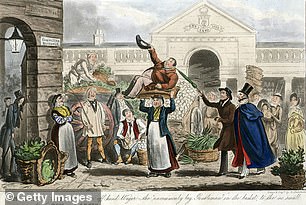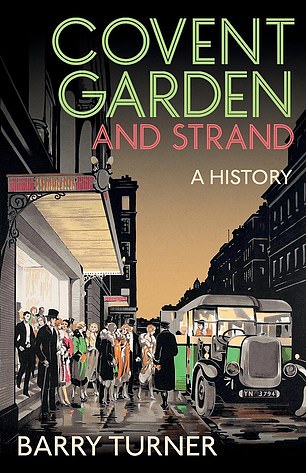Covent Garden and Strand by Barry Turner (Mensch £15, 234pp)
The pavement is already strewed with decayed vegetable leaves,’ Charles Dickens wrote in 1836, ‘… and all the indescribable litter of a vegetable market; men are shouting, carts backing, horses neighing, boys fighting, basket-women talking, piemen announcing the excellence of their pastry, and donkeys braying.’ He was describing Covent Garden market.
For centuries, Covent Garden was renowned for its fruit and vegetable market, which was there until 1974 when it moved out of central London to Nine Elms. However, as Barry Turner reveals in his highly enjoyable history, there was always much more to Covent Garden and its neighbour, Strand.

Circa 1800 – The hustle and bustle of the 19th century market place
It was also a bohemian quarter of the city to which actors, writers and artists flocked. In the 17th and 18th centuries, they gathered in Covent Garden’s coffee houses. Will’s in Russell Street was where the poet John Dryden held court, surrounded by admiring acolytes. Jonathan Swift, author of Gulliver’s Travels, was unimpressed, declaring that the conversation at Will’s was ‘the worst… I have ever heard in my life.’ A much less respectable venue was Moll King’s which, according to one later writer, was ‘congregated with every species of human kind that intemperance, idleness, necessity, or curiosity, could assemble together’. Carpenter’s coffee house was run by a former porter at the market, famous for carrying 15 baskets of produce on his head.
It was not only coffee, fruit and veg that were on sale. So too was sex. In the 18th century, the first edition of Harris’s List of Covent Garden Ladies appeared, a guide to the prostitutes of the neighbourhood. It went through dozens of editions over the next few decades. Miss Bird was ‘a tall, thin, genteel girl agreeable in her manners’ but ‘has a northern brogue and is too often in a state of intoxication’. Poll Talbot was ‘a fair, comely dame’ who ‘loves the smack of the whip sometimes’.

Covent Garden and Strand is available now
Strand, little more than a stone’s throw away from Covent Garden, was once a street of palaces but the great houses have long gone. In the late 19th century and into the early part of the 20th century, it was a major shopping centre.
The Civil Service shop started life as a co-operative venture by a group of enterprising clerks and became one of London’s leading department stores. Stanley Gibbons, still in existence at 399 Strand, has been a mecca for stamp collectors since the 19th century.
One of Strand’s more improbable retail outlets was the Wenham Lake Ice Company. In the days before refrigeration, this sold imported ice from an American lake to London restaurants and householders.
Barry Turner, whose previous work was a similarly anecdotal history of Piccadilly, has an eye for detail that brings the past vividly to life. His new book is a delight, full of unexpected facts and offbeat information.






